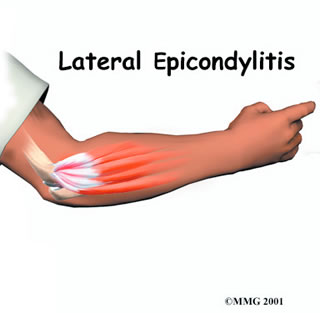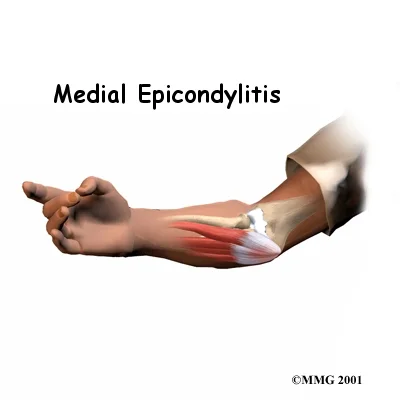Why CrossFit athletes are prone to elbow “tendonitis” and what you can do about it.
Elbow pain in CrossFit athletes is not uncommon and most typically it is related to overuse of the forearm muscles. I am suffering from this right now and relate it to over-practice of butterfly pull ups and ring muscle ups, two skills that I am not yet proficient at and want to practice leading up to the CrossFit Open in February. But, sadly ... I did too much.
So what is elbow tendinitis? Is it caused by tennis? Golf?
We can see joint irritation from hyperextension or poor catching positions with Olympic lifting or gymnastics movements. However, in the clinic, I mostly treat elbow injuries that we would as athletes call elbow tendonitis. This type of soft tissue injury is very commonly mis-explained to patients as inflammation and leads to a mis-understanding of how to treat the issue.
Tennis elbow (Lateral epicondylitis)
The affected structures are located on the outer surface of the elbow. These tendons are part of the forearm/wrist/finger extensor muscle group.
Golfer’s elbow (Medial epicondylitis)
The affected structures are located on the inner surface of the elbow. These tendons are part of the forearm/wrist/finger flexor muscle group.
Elbow tendonitis is actually classified as a repetitive strain injury caused by overuse of the wrist and forearm. The muscles that control wrist movements (flexion, extension, gripping, false gripping) run along the forearm (and underarm) and connect around the elbow joint. Repeated use of these muscles causes strain on the tendons which attach the muscles to the bone. We will label this tendinosis.
The pathophysiology of tendinosis, sadly, is degeneration.
de·gen·er·a·tion
dəˌjenəˈrāSH(ə)n/
noun
noun: degeneration
the state or process of being or becoming degenerate; decline or deterioration.
deterioration and loss of function in the cells of a tissue or organ.
"degeneration of the muscle fibers"
Bad news. This is not a little irritation that can be solved with ice and ibuprofen. We are talking tissue deterioration. Longitudinal sonogram of the lateral elbow displays thickening of the common extensor tendon, calcifications, intrasubstance tears, and marked irregularity of the lateral epicondyle (bony attachment) – in more understandable terms, we see gunked up connections of muscle to bone, scar and adhesions in the soft tissues, bony changes, small tears in the muscles and general abnormality.
Take a minute to let that sink in. YUCK. Although the term “epicondylitis” is frequently used to describe this disorder, most studies have displayed no evidence of an acute, or a chronic inflammatory process. Histologic studies have demonstrated that this condition is the result of tendon degeneration, which causes normal tissue to be replaced by a disorganized arrangement of collagen.
normal arrangement of collagen on left vs. disorganized collagen fibers on right
The biggest differentiating factor clinically?? With tendinosis, patients do not feel relief with icing, NSAIDs or rest. In fact, this condition can go on for several months with no resolve. Anti-inflamatory treatments are the common go-to with these painful issues, and would make more sense if the tendon were inflamed. But, it isn’t.
So, not only do you need to address the pain in the elbow, but also why the elbow may be victimized (poor mechanics in motion, weakness in the shoulder/shoulderblade, poor ergonomics at work, etc). This takes a skilled eye and you can safely bet on a PT or trainer who best understands your sport or work set-up as well as the tendinosis condition.
Many activities can cause this over-use:
Typing on a keyboard
Computer mouse use
Repetitive movements of the hand/elbow
Lifting/carrying
Excessive gripping
However, in CrossFit, we also see that there can be a biomechanical chain of events leading to this problem. Let’s take pull ups for example. If you have weakness in the shoulder girdle and core and have difficulty pulling from these areas, you will likely over-PULL from the elbow tissues. Combine that with a WOD that has snatches (hook grip) and dubs (gripping) in it, and you are looking at overuse. Oh, and you went straight to the gym from the awful work set-up at the office- you know the one … the one where you have a standing desk and never use it, or maybe you travel a lot and sit at your laptop like this guy:
Overuse injuries of the elbow are common among people who are brand new to the sport of CrossFit, but they also present in more seasoned athletes when they find themselves doing lots of pulling or gripping. Movements that increase the activation of forearm muscles: pull ups, T2B, C2B, hook gripping for snatches or cleans, farmers carry, muscle ups, false grip drills, the list goes on… Sadly, even the accessory work that will help you perform these activities better in the gym often utilize gripping movement and can cause overuse. My personal example is loading the wrist extensors eccentrically and isometrically in a lengthened position as I hung in a false grip from the pull up bar to load the tissue and create strength in that position. It was good for me in that it helped me feel strong in that position, but I did too much … And now have elbow pain, likely extensor tendon tendinosis.
Unfortunately, the body (including the joints and tendons) is not conditioned to weather the onset of new and sudden—and often times thousands of repetitions of—movement. In fact, this causes irritation to the supporting tissue. Repetitive movements such as high volume pull ups, push ups, gardening work and even typing for most of the day can lead to tendonitis. Additionally, more trouble can come when combining a sport like CrossFit with other gripping activities, whether work-related (machinists, glass blower, manual therapist, painter, etc) or hobby-related (rock climbing, golf, ultimate Frisbee). Finally, most folks ignore the early warning signs (tenderness, swelling and soreness) and end up ‘pushing through the pain’.
SO HOW DO WE DEAL WITH IT??
Stop all activities that cause the elbow pain. Testing the positions, poking the sore muscles, doing the activities that cause the pain will all delay healing and cause more irritation.
Symtomatic relief: Decrease the pain by using ice or heat. However, recall that this is not actually REDUCING inflammation as there is no inflammation. Might feel good though….
Avoid the use of medication, specifically NSAIDS. Research has demonstrated that the use of these medications actually slows tendon healing as they prevent healthy collagen formation (https://www.ncbi.nlm.nih.gov/pubmed/2810293)
Epicondylar counterforce braces work by reducing the level of tension in the forearm extensors. Several studies have shown that these braces can improve pain and grip strength
Understand healing time. If caught early and treated correctly, tendinosis can take 6-10 weeks to heal. However, once in its chronic stages, this condition can last for 3-6 months. Some studies suggest that it takes 9 months to treat effectively. Knowing these times lines can actually help a patient manage their expectations of outcomes and rest when needed, not push it, do their PT exercises diligently, etc.
Physical Therapy is considered the best treatment for tendinosis of the elbow, where we focus on exercise protocols designed to promote healing and most important: fix damaging biomechanical patterns.
For the patients who do not improve with physical therapy, sports medicine interventions may need to be considered. These might include platelet-rich plasma injections, prolotherapy or use of a nitroglycerine patch.








